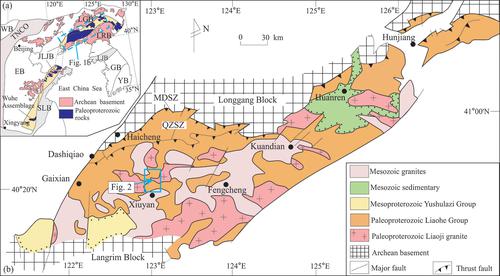当前位置:
X-MOL 学术
›
Acta Geol. Sinica Engl. Ed.
›
论文详情
Our official English website, www.x-mol.net, welcomes your
feedback! (Note: you will need to create a separate account there.)
Geochronology and Geochemistry of Late Triassic Intrusive Rocks in the Xiuyan Area, Liaodong Peninsula, Eastern North China Craton: Petrogenesis and Implications for Lithospheric Thinning
Acta Geologica Sinica-English Edition ( IF 3.5 ) Pub Date : 2021-07-05 , DOI: 10.1111/1755-6724.14793 Yanfei ZHANG 1, 2 , Yang DONG 2, 3 , Rongge XIAO 4 , Jingdang LIU 2 , Baoju ZHAO 4
Acta Geologica Sinica-English Edition ( IF 3.5 ) Pub Date : 2021-07-05 , DOI: 10.1111/1755-6724.14793 Yanfei ZHANG 1, 2 , Yang DONG 2, 3 , Rongge XIAO 4 , Jingdang LIU 2 , Baoju ZHAO 4
Affiliation

|
The timing and mechanisms of lithospheric thinning and destruction of the North China Craton (NCC) remain controversial, and the overall geodynamics of the process are poorly understood. This paper documents Late Triassic igneous rocks including monzogranite, gabbro, and diorite from the Xiuyan District on the Liaodong Peninsula in the eastern NCC, which have LA-ICP-MS zircon U-Pb ages of 229.0 ± 0.4 Ma, 216.2 ± 0.9 Ma, and 210.6 ± 2.0 Ma, respectively. Monzogranite shows high-SiO2 adakite affinity, negative ∊Hf(t) values (–20.6 to –17.9), and old TDM2 ages (3.53–3.29 Ga), suggesting that their parental magma was derived from thickened Paleoarchean mafic lower crust and minor mantle materials that were also involved their generation. Gabbro is ultrapotassic, strongly enriched in LREEs and LILEs, depleted in HFSEs, and has evolved zircon Hf isotopes with negative ∊Hf of –10.04 to –5.85 and old TDM2 ages (2.59 –2.22 Ga). These are diagnostic signatures of a crustal component, but their high contents of MgO, Cr, Co, Ni indicate that the primary magma originated from enriched mantle. Diorite is enriched in LILEs and LREEs, depleted in HFSEs (with negative Nb, Ta, and Ti anomalies), and contains negative ∊Hf(t) values (–13.64 to –11.01). Compared with the gabbro, the diorite is relatively enriched in Nb, Ta and HREEs, and also contains younger TDM2 ages (2.11–1.94 Ga), suggesting that the diorite was formed by mixing between ancient lower crust-derived felsic magmas and asthenospheric mantle-derived magmas. Field observations, geochronology, geochemistry, and zircon Lu-Hf isotopes indicate that Late Triassic magmatism and tectonic activity resulted from deep subduction of the Yangtze Craton beneath the NCC in the Xiuyan area. This phase of tectonic activity was completed in the eastern NCC by the Late Triassic (216 Ma), and was subsequently followed by lithospheric thinning that began in the Late Triassic.
中文翻译:

华北克拉通东部辽东半岛岫岩地区晚三叠世侵入岩年代学和地球化学:岩石成因及其对岩石圈减薄的意义
华北克拉通 (NCC) 岩石圈减薄和破坏的时间和机制仍然存在争议,并且对该过程的整体地球动力学知之甚少。本文记录了华北克拉通东部辽东半岛岫岩区晚三叠世火成岩,包括二长花岗岩、辉长岩和闪长岩,LA-ICP-MS锆石U-Pb年龄分别为229.0±0.4 Ma,216.2±0.9 Ma,和 210.6 ± 2.0 Ma,分别。二长花岗岩显示出高 SiO 2埃达克石亲和力、负∊ Hf ( t ) 值(–20.6 至 –17.9)和旧T DM2年龄(3.53-3.29 Ga),表明它们的母岩浆来自增厚的古太古代基性下地壳和次要的地幔物质,这些物质也参与了它们的产生。辉长岩是超钾元素,富含 LREE 和 LILE,缺乏 HFSE,并且已经演化出锆石 Hf 同位素,负∊ Hf为 –10.04 至 –5.85,T DM2年龄旧(2.59 –2.22 Ga)。这些是地壳成分的诊断特征,但它们高含量的 MgO、Cr、Co、Ni 表明原生岩浆源自富集的地幔。闪长岩富含 LILEs 和 LREEs,耗尽 HFSEs(具有负的 Nb、Ta 和 Ti 异常),并且包含负的∊ Hf ( t) 值(–13.64 到 –11.01)。与辉长岩相比,闪长岩相对富含Nb,Ta和HREEs,并且还包含年轻Ť DM2年龄(2.11-1.94 Ga)的,这表明闪长岩是由古下壳源英质岩浆和软流圈地幔之间混合而形成-衍生的岩浆。野外观测、年代学、地球化学和锆石 Lu-Hf 同位素表明,晚三叠世岩浆活动和构造活动是岫岩地区华北克拉通下方扬子克拉通深俯冲的结果。这一阶段的构造活动在晚三叠世(216 Ma)在华北克拉通东部完成,随后是晚三叠世开始的岩石圈减薄。
更新日期:2021-07-05
中文翻译:

华北克拉通东部辽东半岛岫岩地区晚三叠世侵入岩年代学和地球化学:岩石成因及其对岩石圈减薄的意义
华北克拉通 (NCC) 岩石圈减薄和破坏的时间和机制仍然存在争议,并且对该过程的整体地球动力学知之甚少。本文记录了华北克拉通东部辽东半岛岫岩区晚三叠世火成岩,包括二长花岗岩、辉长岩和闪长岩,LA-ICP-MS锆石U-Pb年龄分别为229.0±0.4 Ma,216.2±0.9 Ma,和 210.6 ± 2.0 Ma,分别。二长花岗岩显示出高 SiO 2埃达克石亲和力、负∊ Hf ( t ) 值(–20.6 至 –17.9)和旧T DM2年龄(3.53-3.29 Ga),表明它们的母岩浆来自增厚的古太古代基性下地壳和次要的地幔物质,这些物质也参与了它们的产生。辉长岩是超钾元素,富含 LREE 和 LILE,缺乏 HFSE,并且已经演化出锆石 Hf 同位素,负∊ Hf为 –10.04 至 –5.85,T DM2年龄旧(2.59 –2.22 Ga)。这些是地壳成分的诊断特征,但它们高含量的 MgO、Cr、Co、Ni 表明原生岩浆源自富集的地幔。闪长岩富含 LILEs 和 LREEs,耗尽 HFSEs(具有负的 Nb、Ta 和 Ti 异常),并且包含负的∊ Hf ( t) 值(–13.64 到 –11.01)。与辉长岩相比,闪长岩相对富含Nb,Ta和HREEs,并且还包含年轻Ť DM2年龄(2.11-1.94 Ga)的,这表明闪长岩是由古下壳源英质岩浆和软流圈地幔之间混合而形成-衍生的岩浆。野外观测、年代学、地球化学和锆石 Lu-Hf 同位素表明,晚三叠世岩浆活动和构造活动是岫岩地区华北克拉通下方扬子克拉通深俯冲的结果。这一阶段的构造活动在晚三叠世(216 Ma)在华北克拉通东部完成,随后是晚三叠世开始的岩石圈减薄。











































 京公网安备 11010802027423号
京公网安备 11010802027423号